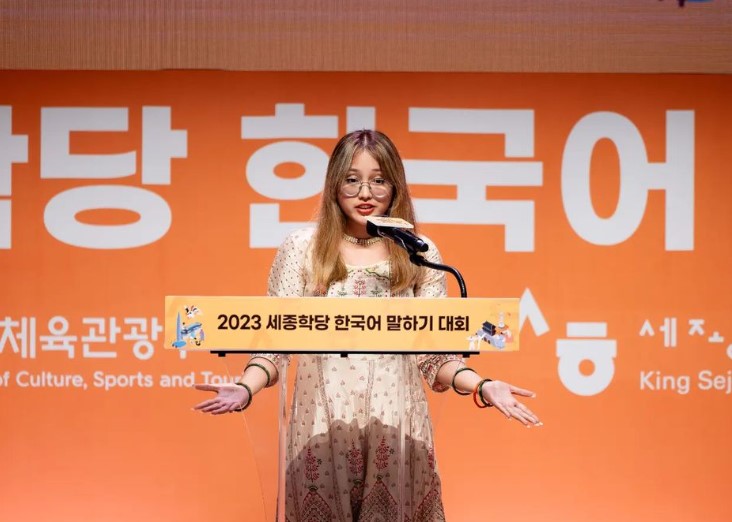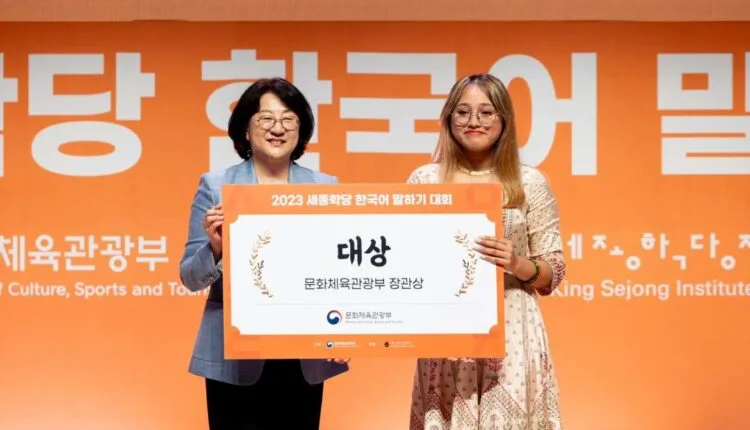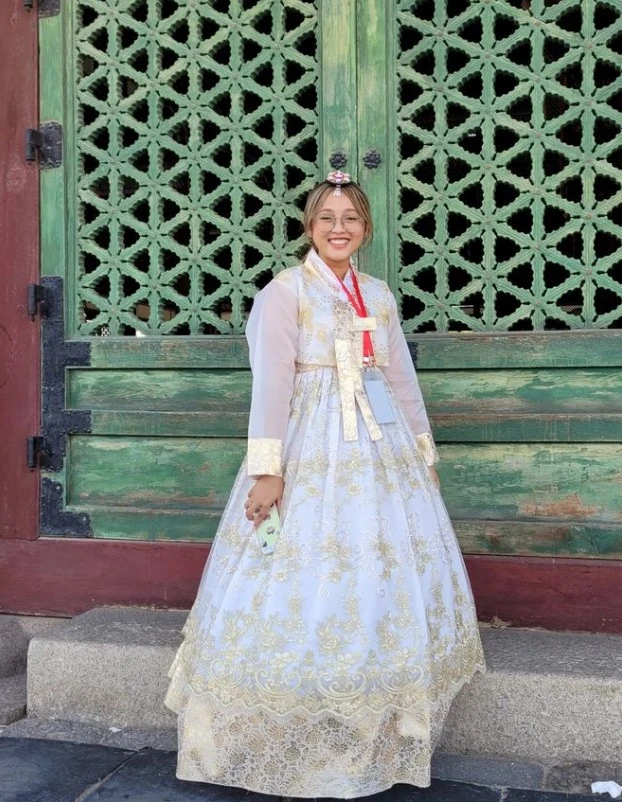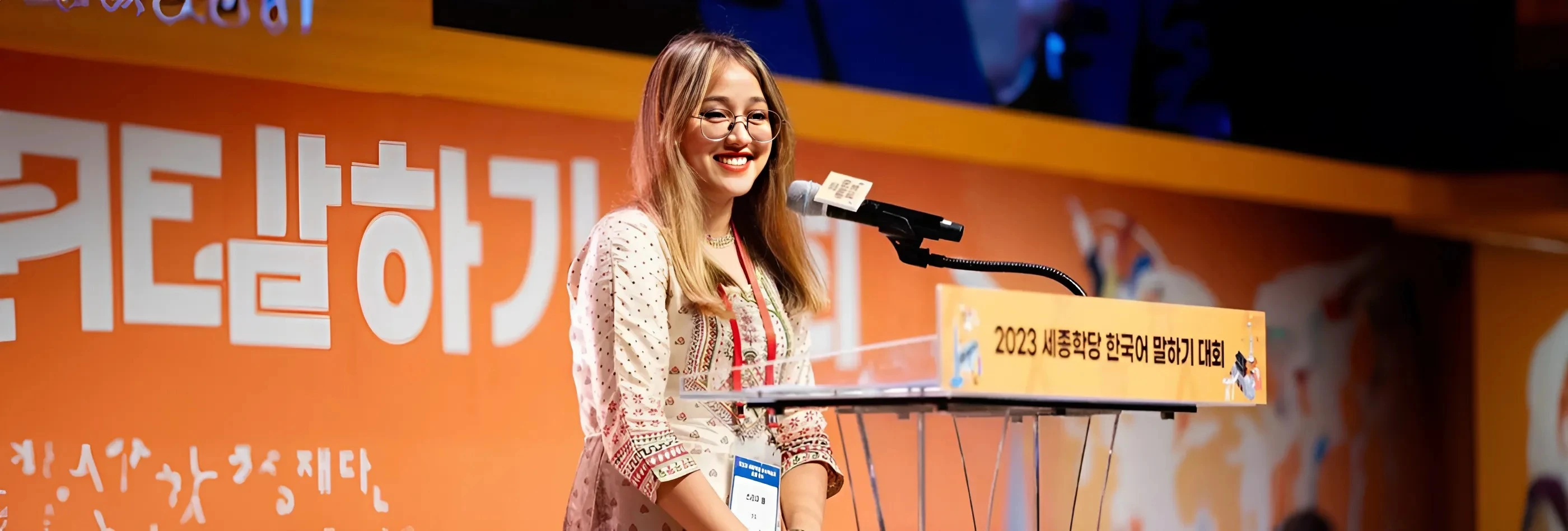(November 9, 2024) “I feel blessed to have come this far in my journey with the Korean language and music,” says Delhi’s Srija Paul, reflecting on the journey that has brought her to the global stage. Srija’s connection with the Korean language began as a quest to understand the lyrics of her favourite K-pop ballads. Over time, it grew into a deep, immersive passion that’s shaping her career path.
In 2024, the 20-year-old achieved a major milestone by winning the grand prize in the “Born To Be A KPOP Star” contest, held in South Korea’s Gyeongsang-do province. This isn’t the first time Srija has made her mark on the international stage. Last year, she claimed the top prize in the Sejong Hakdang Outstanding Learners’ Invitational Training Program, an annual competition for Korean language learners in Seoul. With each achievement, she feels she is getting closer to her ultimate goal – to become a popular professional singer in Korea.

Srija in front of the Blue House, also known as Cheongwa Dae – the official residence of the President of South Korea
After majoring in English Literature at a college in Delhi and completing a basic Korean language course at the Korean Cultural Centre India (KCCI) in New Delhi, she recently began an advanced practical Korean language course at the SNU Language Education Institute in Seoul. Alongside her studies, Srija works as a Korean language trainer on the language exchange platform Hilokal, where she and other trainers hold audio-based classes to help people improve their Korean. She’s also dedicated to building a musical career in South Korea.
Tryst with the Korean language
Srija’s fascination with the Korean language took root in 2017 when a friend introduced her to the world of K-pop. Intrigued by the unfamiliar sounds and rhythms, she found herself drawn to the unique artistry of the genre, especially the ballads. Her growing love for these songs, and the messages she sensed within the lyrics, motivated her to learn Korean. Initially, Srija’s goal was simple – to understand the music on a deeper level. But as she delved into the language, what started as a personal interest transformed into an unshakable passion.
In February 2023, Srija took a definitive step forward by enrolling in a formal Korean language course at the Sejong Hakdang branch of the Korean Cultural Centre India (KCCI) in New Delhi. There, she immersed herself in rigorous language studies, embracing the nuances of Korean grammar, vocabulary, and pronunciation. By the time the Sejong Hakdang Invitational contest came around later that year, Srija was ready to compete with other top learners worldwide.


Srija Paul at the Sejong Hakdang Outstanding Learners’ Invitational speech competition in 2023
Her performance in the competition was nothing short of stellar; she presented the speech titled ‘My Dreams and Challenges in Korean,’ which resonated strongly with both the audience and judges. In her speech, she shared her aspiration of becoming a singer in Korea and spoke candidly about the obstacles she had faced. This victory not only reaffirmed her dedication to the Korean language but also brought her one step closer to achieving her dream.
Winning ‘Born To Be A KPOP Star’ competition in 2024
This year’s ‘Born To Be A KPOP Star’ competition marked another significant milestone in Srija’s journey. The event, held in South Korea’s Gyeongsang-do province, featured contestants from around the world, both online and offline. She got emotional upon hearing her name announced as the grand prize winner. It was a surreal moment, a culmination of years of practice, discipline, and commitment to music. Srija attributes much of her success to her language skills, noting that singing in Korean has allowed her to connect with audiences on a deeper level. By conveying the nuances and emotions of Korean lyrics, she brings authenticity to her performances, which resonates with listeners.


Srija received the first prize in the ‘Born To Be a KPOP Star’ competition as an online participant
Platform for cultural exchange
For Srija Paul, the Sejong Hakdang program and the Korean Cultural Centre, India have provided crucial platforms not only to learn Korean but also to experience Korean culture in its entirety. The Sejong Hakdang Outstanding Learners’ Invitational Training Program, which brought her to Seoul last year, is a collaborative effort between the Sejong Hakdang Foundation and the Ministry of Culture, Sports, and Tourism in South Korea. Each year, the program invites top students from Sejong Hakdang branches worldwide to compete in Korean language skills, and the event is a central part of the annual Hangeul Day celebrations on October 9. In 2023, over 2,400 applicants from 67 countries participated in the program, and Srija emerged as the grand prize winner, joining the ranks of previous winners, including Anubhuti Kakati, another Indian student who won in 2021.
“When they announced my name as the winner during the speech contest, I was filled with happiness and a sense of achievement. In that moment, I felt that I had taken one step closer to my dream,” she remarked.


Srija Paul while receiving the second prize at the Sejong Hakdang Outstanding Learners’ Invitational speech competition
The preliminary rounds took place at the Korean Cultural Centre in New Delhi, where the contestants were given a choice between two topics: ‘Korea as I and Koreans See It’ and ‘The Korean City I Want to Visit and an Introduction to My City.’ “I chose the first and was placed second. In the interview round with a panel of professors from reputable Korean universities, just 10 finalists had made it,” she shared.
The first visit to Korea
Srija’s experience in the Sejong Hakdang program was more than just a competition. It was a chance to immerse herself in Korean culture and connect with other language learners from around the world. In addition to the speech contest, the finalists engaged in a variety of activities during their 6-day, 7-night stay. These included visits to Gyeongbokgung Palace and Yongin Folk Village, a traditional game performance at Namsadang, and a tour of the Blue House. They also experienced aspects of modern Korean culture, such as K-pop dance.
The program’s focus on cross-cultural exchange and learning has had a lasting impact on Srija, reinforcing her desire to contribute to Korean-Indian cultural relations through her music.


Srija visited the Gyeongbok Palace in traditional attire (Hanbok)
“I was happy and teary-eyed when I landed in Korea; my dream had finally come true. I was mesmerized by the country’s beauty. Additionally, everything was so organized there and the roads wide and clean. My favourite activities were wearing Hanbok and visiting the aquarium at Lotte World,” shared the youngster who travelled back this year to pursue Korean language course at SNU Language Education Institute in Seoul, few months back.
Korean culture in India
The influence of Korean culture in India has grown rapidly over the past few years, with the KCCI playing a vital role in nurturing this interest. The KCCI offers a variety of classes in New Delhi, from Korean language courses to Taekwondo and Samulnori (traditional Korean percussion music). In addition to these courses, the KCCI extends its reach by partnering with 32 schools across India, offering Korean language classes and cultural programs to students.
A dream of musical fusion
Srija Paul dreams of sharing a stage with her idols, such as Paul Kim and Jung Seung-hwan, and creating music that speaks to both Indian and Korean audiences. For Srija, singing in Korean is more than a performance – it’s a form of expression that bridges two cultures and resonates with listeners on an emotional level.
“I want to create music that brings Korea and India closer to connect people on a deeper level, and I want to keep learning and spreading knowledge of the Korean language and culture to others,” she tells talking about her ultimate goal. To start, she has been working on collaborative projects with Korean singers.
Srija’s journey from a K-pop enthusiast in Delhi to an award-winning Korean-speaking singer-in-the-making exemplifies the power of passion and perseverance. As she moves forward, the youngster remains committed to her goal – one that transcends borders, celebrating the connections that music and culture create across continents.
For her, the Korean language has been more than just words and phrases – it has been the key that opened a door to her greatest dream.




